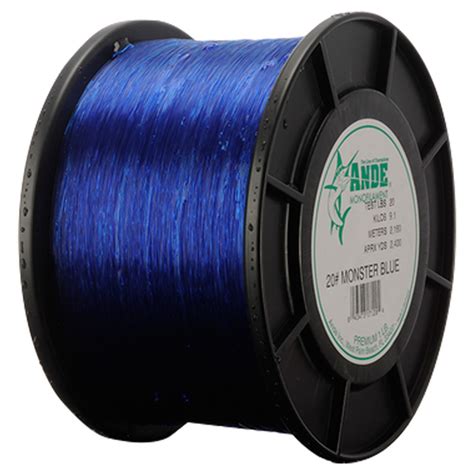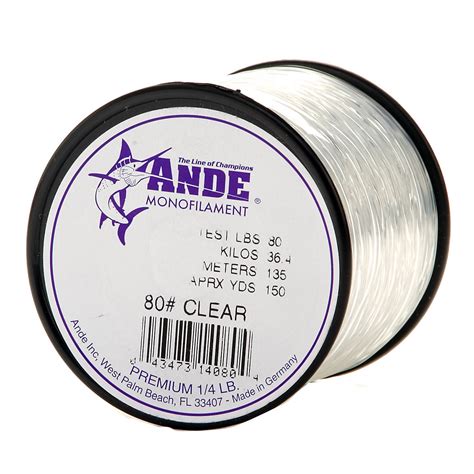What is ANDE Monofilament Monster?
ANDE Monofilament Monster is a fishing line that has gained popularity among fishermen for its strength and durability. This monofilament line is made with a high-quality material that withstands the wear and tear of extreme fishing conditions. This line is ideal for catching large and powerful fish species, such as tuna, marlin, and shark.
ANDE Monofilament Monster is known for its toughness, which makes it perfect for offshore fishing. The line has a high abrasion resistance, enabling it to withstand rough surfaces, such as rocks and coral reefs. This means that the line does not easily break when rubbed against these surfaces, providing you with a better chance of hauling in a catch successfully.
Another feature that sets ANDE Monofilament Monster apart is its excellent knot strength. This enables you to tie knots securely, making it less likely for the line to slip or weaken over time. The line also has a low memory, which means that it doesn't easily retain the shape of the spool, ensuring that it can be cast smoothly and efficiently.
ANDE Monofilament Monster is available in various sizes and strengths to cater to different fishing needs. Whether you're a beginner or an experienced angler, this line is an excellent choice for your next fishing trip. Its durability, strength, and toughness make it an outstanding choice for catching large and challenging game fish. With ANDE Monofilament Monster, you can be confident that you have the right equipment to help you reel in your next big catch.
Frequently Asked Questions about ande monofilament monster
Monofilament can be extruded from different materials, but nylon is by far the most common and popular medium. Often, different varieties of nylon are blended together into co- and multi-polymers to produce varying degrees of stretch, strength, abrasion resistance and other important attributes.
Monofilament is neutrally buoyant by nature and is effective in fishing topwater lures as well as lures which require a line to neither sink nor float, such as hard jerkbaits. Additionally, monofilament line has long been used for backing (A.K.A. "filler") for fishing reels.
Synthetic monofilament fibers are produced by extruding a melted polymer through small spinneret holes. This process is well known and is broadly applied in industry. The preparation, melting, and extrusion of the polymer are similar to those used for film blowing, die casting, and various fiber spinning processes.
Some modern monofilament lines are made from polyvinylidene fluoride (PVDF), a fluoropolymer often marketed as fluorocarbon. Fluorocarbon lines or "fluoro lines" are valued for their similar refractive index to that of water, making it less visible to fish, which may not swallow the bait if it sees the line.
Monofilaments, often called Semmes-Weinstein mono-filaments, are calibrated, single-fiber nylon threads, identified by values ranging from 1.65 to 6.65, that generate a reproducible buckling stress.
Monofilaments are produced in a melt spinning process. The polymer is melted in the extruder and conveyed under pressure to the spinning unit, then it is quenched, stretched, annealed to get the filament of enhanced properties. The material is fed into a standard extruder where it is plasticated.
Cite
| . | Monofilament number | Sensory perception [2] |
|---|
| Green | 2.83 | Normal |
| Blue | 3.61 | Diminished light touch |
| Purple | 4.31 | Diminished protective sensation |
| Red | 4.56 | Loss of protective sensation |
Monofilament examination is used to assess high risk foot for diabetes foot ulcers. It is to assess pressure sensation perception. It is reliable in screening for patients at risk of foot ulceration because sensitivity is a more important parameter [1]. Monofilament examination is inexpensive and non invasive.
In 1937, Warren Carrosas of DuPont succeeded in synthesizing the world's first nylon (66 nylon) line. This new synthetic line was a fiber made of water, air and coal, with very high strength and thin as spider silk. Many anglers today commonly refer to nylon lines as monofilament.
In 1937, Warren Carrosas of DuPont succeeded in synthesizing the world's first nylon (66 nylon) line. This new synthetic line was a fiber made of water, air and coal, with very high strength and thin as spider silk. Many anglers today commonly refer to nylon lines as monofilament.
From the name alone, there is not much you can surmise as to what monofilament does. Mono means one and filament is a slender threadlike object. Put it together and it says one slender threadlike object.
Semmes-Weinstein Monofilament Testing (SWMT)
The test at 3, 4, 8, and 10 points of the feet were evaluated. Three points in each foot were the great toe, the plantar aspect of the first metatarsal head; and the plantar aspect of the fifth metatarsal head.
What is a monofilament test? A monofilament test, formally called a Semmes-Weinstein monofilament ( SWM) test, is done by a doctor, nurse or CDE to test for nerve damage.
Monofilament. Pros: Good knot strength; suitable for a wide range of common fishing knots; smooth and easily castable; low visibility; good color retention; generally good abrasion resistance; floats; economical price.














